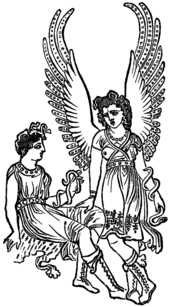reworking for greater clarity and precision |
restoring sourced content, which was removed without a reason |
||
| Line 1: | Line 1: | ||
[[Image:Deux furies.png|thumb|upright|Two Furies, from an ancient vase.]] |
[[Image:Deux furies.png|thumb|upright|Two Furies, from an ancient vase.]] |
||
{{redirect|Furies}} |
{{redirect|Furies}} |
||
In [[Greek mythology]] the '''Erinyes''' (Ἐρινύες, pl. of Ἐρινύς, Erinys; literally "the avengers") from Greek ἐρίνειν " pursue, persecute"--sometimes referred to as "infernal goddesses" (Greek χθόνιαι θεαί)- |
In [[Greek mythology]] the '''Erinyes''' (Ἐρινύες, pl. of Ἐρινύς, Erinys; literally "the avengers") from Greek ἐρίνειν " pursue, persecute"--sometimes referred to as "infernal goddesses" (Greek χθόνιαι θεαί) or '''Eumenides''' (Εὐμενίδες, pl. of Εὐμενίς; literally "the gracious ones" but also translated as "Kind-hearted Ones" or "Kindly Ones")<ref>''Suid''. s. v. Ἄλλα δ' ἀλλαχοῦ καλά</ref><ref>http://www.theoi.com/Khthonios/Erinyes.html</ref> were female [[chthonic]] [[deity|deities]] of [[revenge|vengeance]]. A formulaic oath in the ''[[Iliad]]'' invokes them as "those who beneath the earth punish whosoever has sworn a false oath".<ref>''Iliad'' iii.278ff; xix.260ff</ref> [[Walter Burkert|Burkert]] suggests they are "an embodiment of the act of self-[[cursing]] contained in the oath".<ref>Burkert 1985, p. 198</ref> |
||
They correspond to the '''Furies''' or '''Dirae''' in [[Roman mythology]] |
They correspond to the '''Furies''' or '''Dirae''' in [[Roman mythology]] |
||
Revision as of 07:11, 11 September 2011

In Greek mythology the Erinyes (Ἐρινύες, pl. of Ἐρινύς, Erinys; literally "the avengers") from Greek ἐρίνειν " pursue, persecute"--sometimes referred to as "infernal goddesses" (Greek χθόνιαι θεαί) or Eumenides (Εὐμενίδες, pl. of Εὐμενίς; literally "the gracious ones" but also translated as "Kind-hearted Ones" or "Kindly Ones")[1][2] were female chthonic deities of vengeance. A formulaic oath in the Iliad invokes them as "those who beneath the earth punish whosoever has sworn a false oath".[3] Burkert suggests they are "an embodiment of the act of self-cursing contained in the oath".[4]
They correspond to the Furies or Dirae in Roman mythology
When the Titan Cronus castrated his father Uranus and threw his genitalia into the sea, the Erinyes emerged from the drops of blood, while Aphrodite was born from the crests of seafoam. According to variant accounts,[5][6][7] [8] they emerged from an even more primordial level—from Nyx, "Night". Their number is usually left indeterminate. Virgil, probably working from an Alexandrian source, recognized three: Alecto ("unceasing", who appeared in Virgil's Aeneid), Megaera ("grudging"), and Tisiphone ("avenging murder"). Dante followed Virgil in depicting the same three-charactered triptych of Erinyes; in Canto IX of the Inferno they confront the poets at the gates of the city of Dis. The heads of the Erinyes were wreathed with serpents (compare Gorgon) and their eyes dripped with blood, rendering their appearance rather horrific. Other depictions show them with the wings of a bat or bird and the body of a dog.
Evolution in Greek Tragedy
In Aeschylus's "Eumenides", the Erinyes chase Orestes to avenge Clytemnestra, his mother. Orestes killed Clytemnestra to avenge the murder of his father, Agamemnon. The Erinyes chase Orestes to Athens where Athena then intervenes. She and the Athenians judge whether Orestes deserves the wrath of Erinyes and rule in favor of Orestes. Athena, in order to appease the Erinyes, promises them the love of Athens and the play ends with them accompanied by a processional escort who now address them as "Semnai" (Venerable ones). They are given red robes to replace the black robes they wore for most of the play. In Euripides Orestes (play) they are for the first time "equated"[9] with the Eumenides (Εὐμενίδες, pl. of Εὐμενίς; literally "the gracious ones" but also translated as "Kindly Ones"[10][11])
Notes
| Greek deities series |
|---|
| Chthonic deities |
- ^ Suid. s. v. Ἄλλα δ' ἀλλαχοῦ καλά
- ^ http://www.theoi.com/Khthonios/Erinyes.html
- ^ Iliad iii.278ff; xix.260ff
- ^ Burkert 1985, p. 198
- ^ Aeschyluls Eumenides 321
- ^ Lycophron 432
- ^ Virgil Aeneid 6.250
- ^ Ovid Metamorphoses 4.453
- ^ Timothy Gantz, Early Greek Myth: A Guide to Literary and Artistic Sources,1993,Johns Hopkins University Press,p832
- ^ Suid. s. v. Ἄλλα δ' ἀλλαχοῦ καλά
- ^ http://www.theoi.com/Khthonios/Erinyes.html